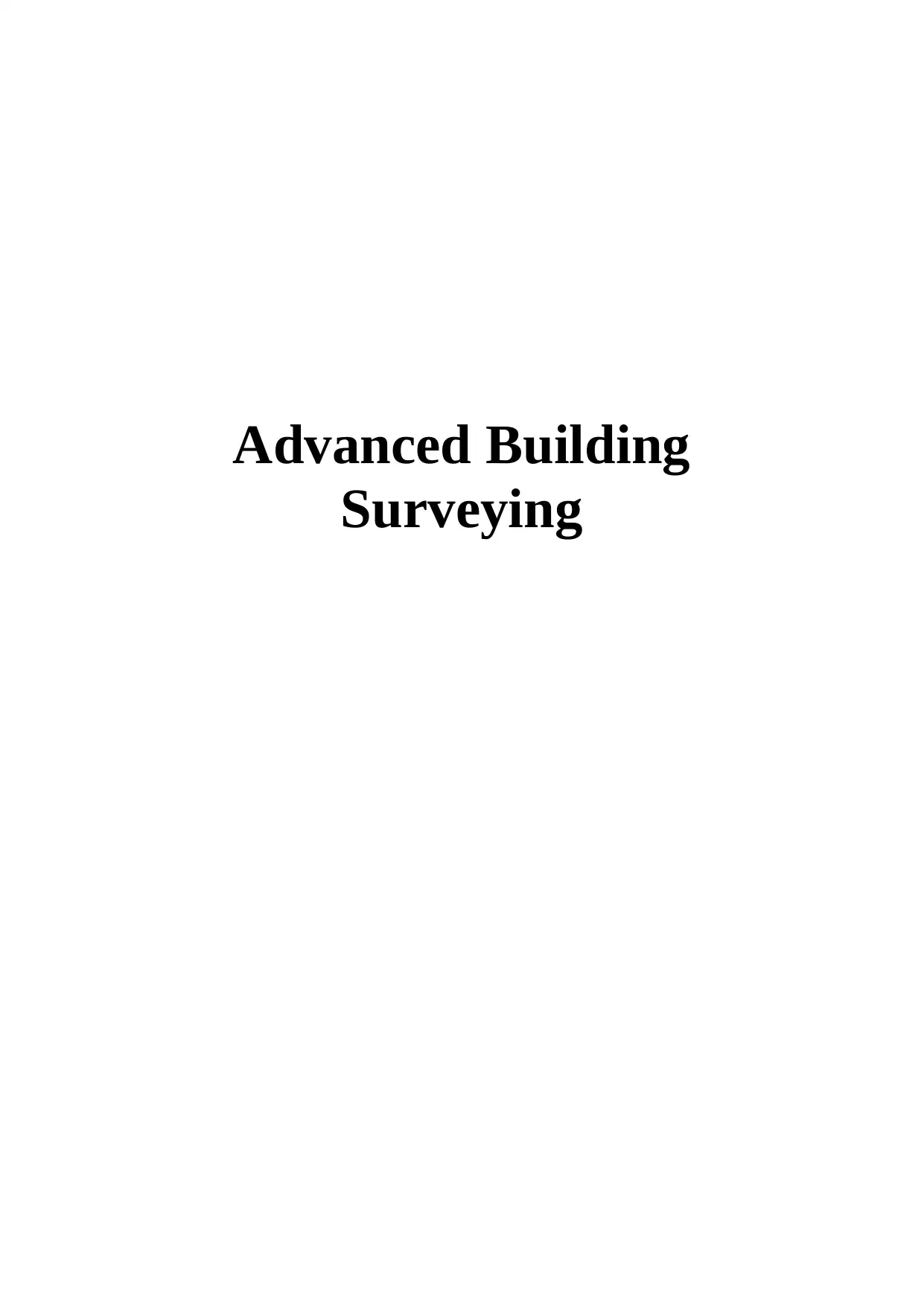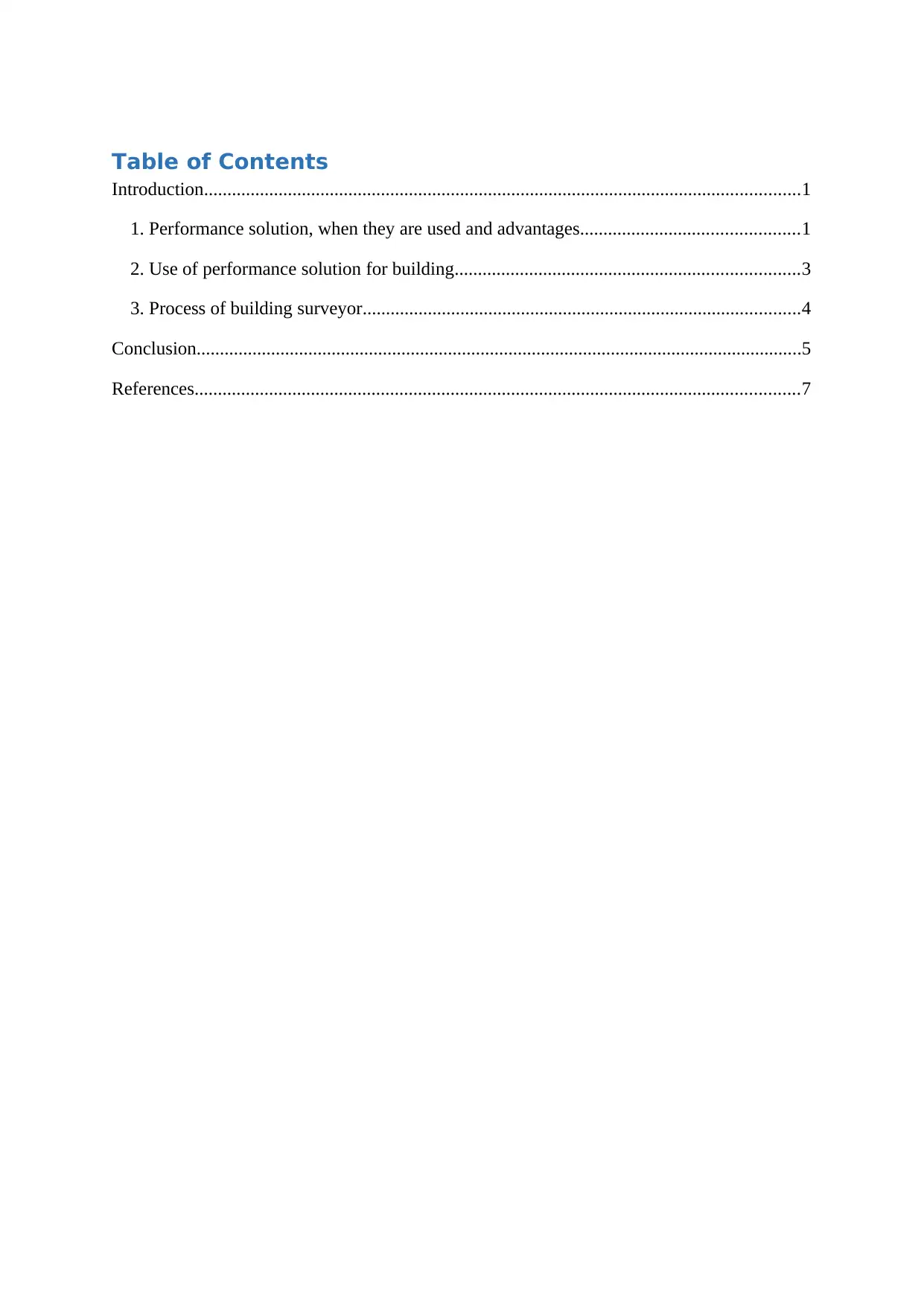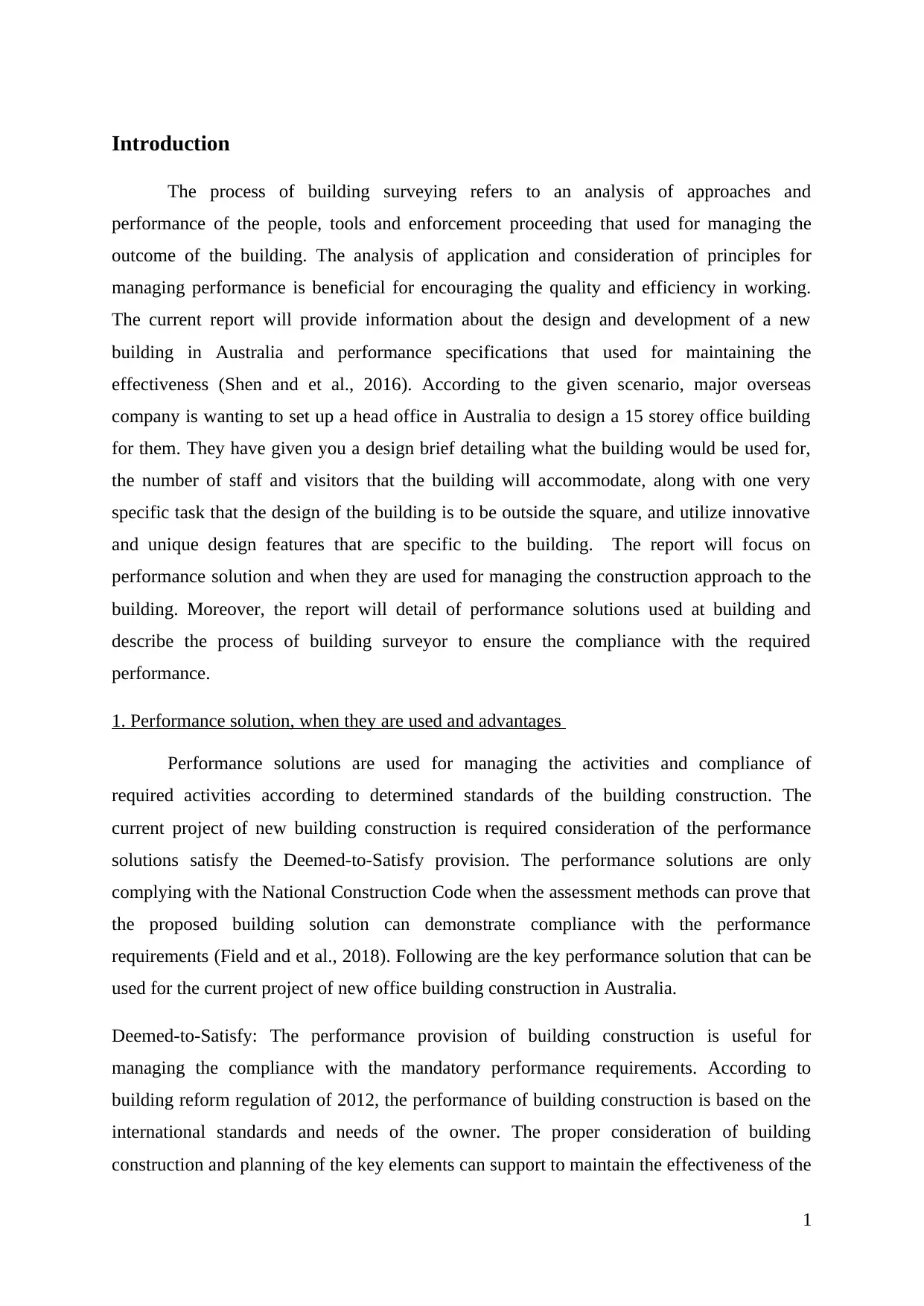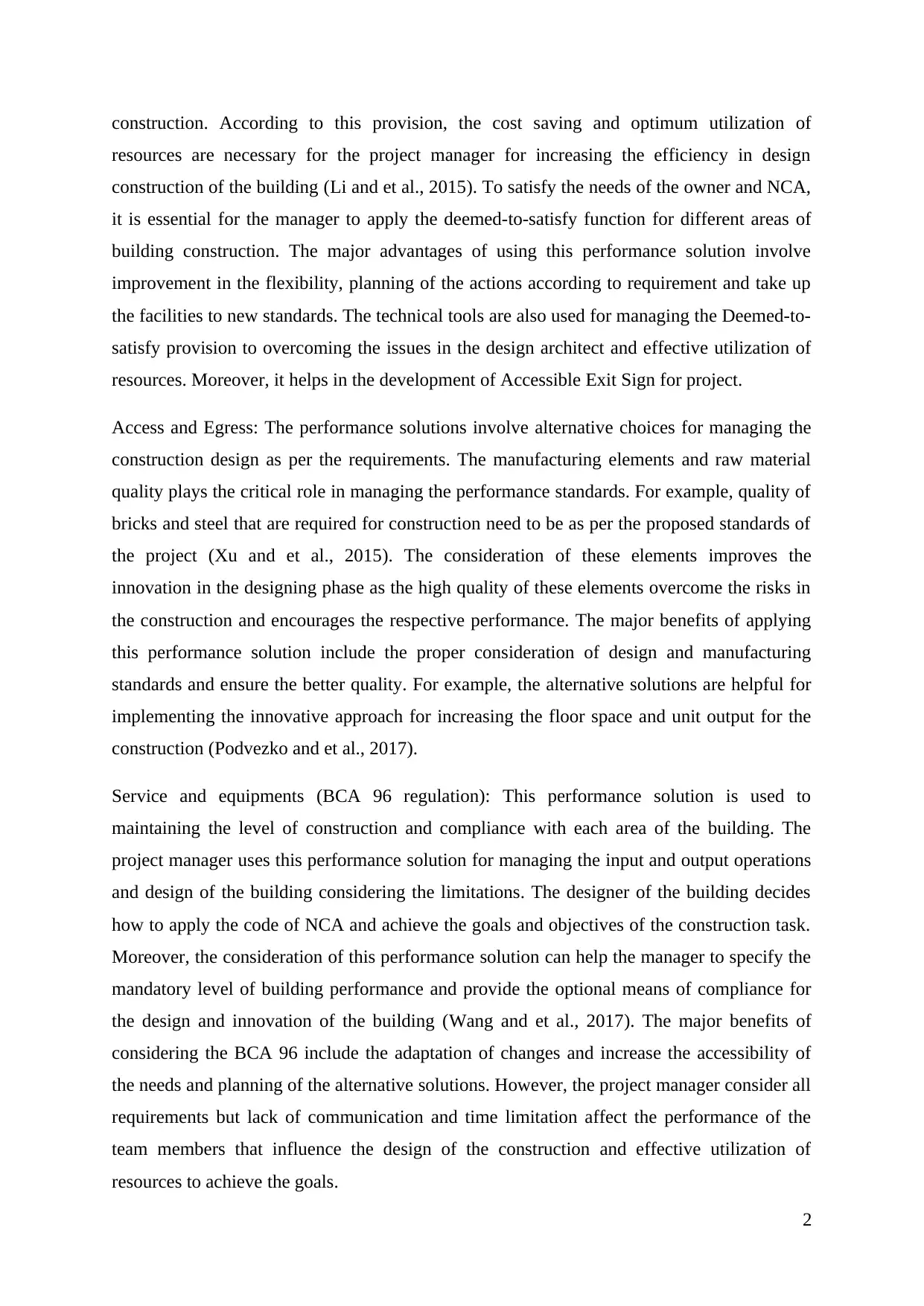Performance-Based Design and Building Surveying Analysis Report
VerifiedAdded on 2023/06/04
|11
|2694
|123
Report
AI Summary
This report delves into the realm of building performance solutions, focusing on the design and construction of a 15-story office building in Australia for a major overseas company. It explores the application of performance-based design, contrasting it with deemed-to-satisfy provisions of the BCA. The report highlights key performance solutions such as fire resistance, access and egress, and service and equipment considerations, referencing the BCA 2016 codes. It also examines the role of a building surveyor in ensuring compliance with design standards and regulations, detailing the surveying process across various building elements like roof spaces, rooms, basements, and drainage systems. The analysis emphasizes the importance of innovative design features while adhering to performance-based codes to achieve a high-quality, safe, and efficient building. The report concludes by summarizing the significant impact of performance solutions on building design and construction, emphasizing the benefits of integrating surveyor recommendations for optimal outcomes.

Advanced Building
Surveying
Surveying
Paraphrase This Document
Need a fresh take? Get an instant paraphrase of this document with our AI Paraphraser

Table of Contents
Introduction................................................................................................................................1
1. Performance solution, when they are used and advantages...............................................1
2. Use of performance solution for building..........................................................................3
3. Process of building surveyor..............................................................................................4
Conclusion..................................................................................................................................5
References..................................................................................................................................7
Introduction................................................................................................................................1
1. Performance solution, when they are used and advantages...............................................1
2. Use of performance solution for building..........................................................................3
3. Process of building surveyor..............................................................................................4
Conclusion..................................................................................................................................5
References..................................................................................................................................7

List of tables
Table 1: Fire resistance..............................................................................................................3
Table 1: Fire resistance..............................................................................................................3
⊘ This is a preview!⊘
Do you want full access?
Subscribe today to unlock all pages.

Trusted by 1+ million students worldwide

Introduction
The process of building surveying refers to an analysis of approaches and
performance of the people, tools and enforcement proceeding that used for managing the
outcome of the building. The analysis of application and consideration of principles for
managing performance is beneficial for encouraging the quality and efficiency in working.
The current report will provide information about the design and development of a new
building in Australia and performance specifications that used for maintaining the
effectiveness (Shen and et al., 2016). According to the given scenario, major overseas
company is wanting to set up a head office in Australia to design a 15 storey office building
for them. They have given you a design brief detailing what the building would be used for,
the number of staff and visitors that the building will accommodate, along with one very
specific task that the design of the building is to be outside the square, and utilize innovative
and unique design features that are specific to the building. The report will focus on
performance solution and when they are used for managing the construction approach to the
building. Moreover, the report will detail of performance solutions used at building and
describe the process of building surveyor to ensure the compliance with the required
performance.
1. Performance solution, when they are used and advantages
Performance solutions are used for managing the activities and compliance of
required activities according to determined standards of the building construction. The
current project of new building construction is required consideration of the performance
solutions satisfy the Deemed-to-Satisfy provision. The performance solutions are only
complying with the National Construction Code when the assessment methods can prove that
the proposed building solution can demonstrate compliance with the performance
requirements (Field and et al., 2018). Following are the key performance solution that can be
used for the current project of new office building construction in Australia.
Deemed-to-Satisfy: The performance provision of building construction is useful for
managing the compliance with the mandatory performance requirements. According to
building reform regulation of 2012, the performance of building construction is based on the
international standards and needs of the owner. The proper consideration of building
construction and planning of the key elements can support to maintain the effectiveness of the
1
The process of building surveying refers to an analysis of approaches and
performance of the people, tools and enforcement proceeding that used for managing the
outcome of the building. The analysis of application and consideration of principles for
managing performance is beneficial for encouraging the quality and efficiency in working.
The current report will provide information about the design and development of a new
building in Australia and performance specifications that used for maintaining the
effectiveness (Shen and et al., 2016). According to the given scenario, major overseas
company is wanting to set up a head office in Australia to design a 15 storey office building
for them. They have given you a design brief detailing what the building would be used for,
the number of staff and visitors that the building will accommodate, along with one very
specific task that the design of the building is to be outside the square, and utilize innovative
and unique design features that are specific to the building. The report will focus on
performance solution and when they are used for managing the construction approach to the
building. Moreover, the report will detail of performance solutions used at building and
describe the process of building surveyor to ensure the compliance with the required
performance.
1. Performance solution, when they are used and advantages
Performance solutions are used for managing the activities and compliance of
required activities according to determined standards of the building construction. The
current project of new building construction is required consideration of the performance
solutions satisfy the Deemed-to-Satisfy provision. The performance solutions are only
complying with the National Construction Code when the assessment methods can prove that
the proposed building solution can demonstrate compliance with the performance
requirements (Field and et al., 2018). Following are the key performance solution that can be
used for the current project of new office building construction in Australia.
Deemed-to-Satisfy: The performance provision of building construction is useful for
managing the compliance with the mandatory performance requirements. According to
building reform regulation of 2012, the performance of building construction is based on the
international standards and needs of the owner. The proper consideration of building
construction and planning of the key elements can support to maintain the effectiveness of the
1
Paraphrase This Document
Need a fresh take? Get an instant paraphrase of this document with our AI Paraphraser

construction. According to this provision, the cost saving and optimum utilization of
resources are necessary for the project manager for increasing the efficiency in design
construction of the building (Li and et al., 2015). To satisfy the needs of the owner and NCA,
it is essential for the manager to apply the deemed-to-satisfy function for different areas of
building construction. The major advantages of using this performance solution involve
improvement in the flexibility, planning of the actions according to requirement and take up
the facilities to new standards. The technical tools are also used for managing the Deemed-to-
satisfy provision to overcoming the issues in the design architect and effective utilization of
resources. Moreover, it helps in the development of Accessible Exit Sign for project.
Access and Egress: The performance solutions involve alternative choices for managing the
construction design as per the requirements. The manufacturing elements and raw material
quality plays the critical role in managing the performance standards. For example, quality of
bricks and steel that are required for construction need to be as per the proposed standards of
the project (Xu and et al., 2015). The consideration of these elements improves the
innovation in the designing phase as the high quality of these elements overcome the risks in
the construction and encourages the respective performance. The major benefits of applying
this performance solution include the proper consideration of design and manufacturing
standards and ensure the better quality. For example, the alternative solutions are helpful for
implementing the innovative approach for increasing the floor space and unit output for the
construction (Podvezko and et al., 2017).
Service and equipments (BCA 96 regulation): This performance solution is used to
maintaining the level of construction and compliance with each area of the building. The
project manager uses this performance solution for managing the input and output operations
and design of the building considering the limitations. The designer of the building decides
how to apply the code of NCA and achieve the goals and objectives of the construction task.
Moreover, the consideration of this performance solution can help the manager to specify the
mandatory level of building performance and provide the optional means of compliance for
the design and innovation of the building (Wang and et al., 2017). The major benefits of
considering the BCA 96 include the adaptation of changes and increase the accessibility of
the needs and planning of the alternative solutions. However, the project manager consider all
requirements but lack of communication and time limitation affect the performance of the
team members that influence the design of the construction and effective utilization of
resources to achieve the goals.
2
resources are necessary for the project manager for increasing the efficiency in design
construction of the building (Li and et al., 2015). To satisfy the needs of the owner and NCA,
it is essential for the manager to apply the deemed-to-satisfy function for different areas of
building construction. The major advantages of using this performance solution involve
improvement in the flexibility, planning of the actions according to requirement and take up
the facilities to new standards. The technical tools are also used for managing the Deemed-to-
satisfy provision to overcoming the issues in the design architect and effective utilization of
resources. Moreover, it helps in the development of Accessible Exit Sign for project.
Access and Egress: The performance solutions involve alternative choices for managing the
construction design as per the requirements. The manufacturing elements and raw material
quality plays the critical role in managing the performance standards. For example, quality of
bricks and steel that are required for construction need to be as per the proposed standards of
the project (Xu and et al., 2015). The consideration of these elements improves the
innovation in the designing phase as the high quality of these elements overcome the risks in
the construction and encourages the respective performance. The major benefits of applying
this performance solution include the proper consideration of design and manufacturing
standards and ensure the better quality. For example, the alternative solutions are helpful for
implementing the innovative approach for increasing the floor space and unit output for the
construction (Podvezko and et al., 2017).
Service and equipments (BCA 96 regulation): This performance solution is used to
maintaining the level of construction and compliance with each area of the building. The
project manager uses this performance solution for managing the input and output operations
and design of the building considering the limitations. The designer of the building decides
how to apply the code of NCA and achieve the goals and objectives of the construction task.
Moreover, the consideration of this performance solution can help the manager to specify the
mandatory level of building performance and provide the optional means of compliance for
the design and innovation of the building (Wang and et al., 2017). The major benefits of
considering the BCA 96 include the adaptation of changes and increase the accessibility of
the needs and planning of the alternative solutions. However, the project manager consider all
requirements but lack of communication and time limitation affect the performance of the
team members that influence the design of the construction and effective utilization of
resources to achieve the goals.
2

2. Use of performance solution for building
For example, the performance solution that used for design and development of new
building office involve section C from BCA 2016 version. This performance solution is
about fire resistance and implementation of functions that can encourage the effectiveness of
design in terms of fire case (Liu and Kelly, 2014). According to the solution of BCA section
C, the consideration of hazardous properties that could lead to the fire includes the floor
material, coverage, material that used for wall and ceiling lines. The components that are
used for managing fire safety and implementation of equipment involve the following
elements:
Table 1: Fire resistance
Required compliance Comment
Vertical separation Proper knowledge about the design and
compliance of building unit
Classification of different storey The implementation of 120/120/120 standards for
floor separation and car parking of the building
Lift shaft Load bearing
Basement level 2 and 3
Non-load bearing
Level 2 and 1
Electricity supply Any substation equipment that can cause fire are
properly monitored and installed to overcome the
issues of fire resistance. The emergency mode
must be separated by construction focusing on
FRL (Eperon and et al., 2014).
The proper implementation of fire resistance function in building for new office
development of an overseas organization in Australia, the project site manager will focus on
the performance solution like protection of opening in external walls and service penetration.
In addition to this, the design compliance of building for different areas such as rooms, visitor
3
For example, the performance solution that used for design and development of new
building office involve section C from BCA 2016 version. This performance solution is
about fire resistance and implementation of functions that can encourage the effectiveness of
design in terms of fire case (Liu and Kelly, 2014). According to the solution of BCA section
C, the consideration of hazardous properties that could lead to the fire includes the floor
material, coverage, material that used for wall and ceiling lines. The components that are
used for managing fire safety and implementation of equipment involve the following
elements:
Table 1: Fire resistance
Required compliance Comment
Vertical separation Proper knowledge about the design and
compliance of building unit
Classification of different storey The implementation of 120/120/120 standards for
floor separation and car parking of the building
Lift shaft Load bearing
Basement level 2 and 3
Non-load bearing
Level 2 and 1
Electricity supply Any substation equipment that can cause fire are
properly monitored and installed to overcome the
issues of fire resistance. The emergency mode
must be separated by construction focusing on
FRL (Eperon and et al., 2014).
The proper implementation of fire resistance function in building for new office
development of an overseas organization in Australia, the project site manager will focus on
the performance solution like protection of opening in external walls and service penetration.
In addition to this, the design compliance of building for different areas such as rooms, visitor
3
⊘ This is a preview!⊘
Do you want full access?
Subscribe today to unlock all pages.

Trusted by 1+ million students worldwide

area and database the implementation of fire isolated shafts is essential. For example, the
project manager for new office building construction will set the fire alarm and fire
extinguishers to overcome the impact of heat on the people (Pecunia and et al., 2015).
Moreover, the monitoring of material that used for construction should be free from catching
fire. This kind of performance solution for building construction will help to maintain the
quality and overcome the unnecessary stress of the project manager to maintain the design
specification and develop the risk-free building space. The aspects that are going to be
considered for fire-resistant building involve the fire resistant glass for windows, use of
stones, bricks, and concrete for construction of the building. For example, the construction of
building in bricks can resist the heat up to 1200 degree C. If there is the high quality of bricks
and glasses were used in the construction of the building can increase the fire resistant (Nie
and et al., 2015).
3. Process of building surveyor
The survey of the building during and after construction is essential for managing and
achieving the requirements and maintaining the effectiveness for overall functioning. The
surveyor conducts the analysis of design and planning character and provides the description
of the property whether it is detached, semi-detached and terraced. The recommendations of
the surveyor are helpful for maintaining the construction work according to determined
specification and NCA regulations (Liddy and Turner, 2018). The aims of building surveyor
include the documentation of present conditions of property; highlight the areas of failure and
concern, identifying the issues and conservation problems as well as the estimation of the
cost and time. However, there are some issues that affect the construction quality and work of
the project manager but consideration of recommendations of the building surveyor can
influence the approach and quality of the construction. The performance solutions that
proposed by the surveyor can help in the selection of alternative operations for better
utilization of resources and space for the building design. The process of building surveyor
includes the flowing elements:
Roof space: The ceiling insulation and layout of the roof has the significant impact on the
design and consideration of space for the further construction in building and room. The
surveyor takes a note on the chimneys areas, accessible wiring and plumbing areas for
maintaining the effectiveness in building design. For example, the surveyor will analyze the
4
project manager for new office building construction will set the fire alarm and fire
extinguishers to overcome the impact of heat on the people (Pecunia and et al., 2015).
Moreover, the monitoring of material that used for construction should be free from catching
fire. This kind of performance solution for building construction will help to maintain the
quality and overcome the unnecessary stress of the project manager to maintain the design
specification and develop the risk-free building space. The aspects that are going to be
considered for fire-resistant building involve the fire resistant glass for windows, use of
stones, bricks, and concrete for construction of the building. For example, the construction of
building in bricks can resist the heat up to 1200 degree C. If there is the high quality of bricks
and glasses were used in the construction of the building can increase the fire resistant (Nie
and et al., 2015).
3. Process of building surveyor
The survey of the building during and after construction is essential for managing and
achieving the requirements and maintaining the effectiveness for overall functioning. The
surveyor conducts the analysis of design and planning character and provides the description
of the property whether it is detached, semi-detached and terraced. The recommendations of
the surveyor are helpful for maintaining the construction work according to determined
specification and NCA regulations (Liddy and Turner, 2018). The aims of building surveyor
include the documentation of present conditions of property; highlight the areas of failure and
concern, identifying the issues and conservation problems as well as the estimation of the
cost and time. However, there are some issues that affect the construction quality and work of
the project manager but consideration of recommendations of the building surveyor can
influence the approach and quality of the construction. The performance solutions that
proposed by the surveyor can help in the selection of alternative operations for better
utilization of resources and space for the building design. The process of building surveyor
includes the flowing elements:
Roof space: The ceiling insulation and layout of the roof has the significant impact on the
design and consideration of space for the further construction in building and room. The
surveyor takes a note on the chimneys areas, accessible wiring and plumbing areas for
maintaining the effectiveness in building design. For example, the surveyor will analyze the
4
Paraphrase This Document
Need a fresh take? Get an instant paraphrase of this document with our AI Paraphraser

architect design and layout for ceiling solutions to improve the other functions of the building
(Murtagh and et al., 2018).
Room by room: The inspection process of surveyor involves consideration of design elements
of rooms in the building. For the new office construction, the rooms will be designed
according to the working and visitors areas specification of the NCA. The building surveyor
will analyze material quality, walls ceiling, and floor by tapping and provide the additional
advice for making the changes.
Basement, cellars and sub-floor: For these areas, the surveyor takes special concern for
utilization of raw material. The unsafe sub-floor and basement design can affect overall
construction design of the building and influence the future development.
Drains: This is one of the important areas of building survey as the loophole in the drain can
cause the damage to the building and lead to collapse. The proper consideration of drainage
system for building and covering of the main whole is essential for maintaining the safety and
security of the people who come for visit and working (Nadeem and et al., 2015).
Site and surrounding: The surveyor will make concern over site location and surrounding
areas. The condition of boundaries walls and fences can be measured according to the NCA
standards. The surveyor will give input about issues and lack of standards that must be
considered for designing and proper implementation of safety tools.
Other factors that also considered by the surveyor for evaluating the performance of
the construction team involve the examination of ground level, floor covering, equipment that
used for developing design as well as safe access (Williams, 2015). The proper consideration
of surveyor input for design implementation of design standards will increase the
effectiveness of the new office building construction in Australia.
Conclusion
From the above study, it has been carried out that performance solutions are having
the significant impact on the design and construction of the building. The report has provided
information about key performance solutions like Access and Egress, use of services and
equipment and fire resistant for new office development for an overseas organization in
Australia. The report has considered the BCA, 2016 codes proposed by the NCA for
5
(Murtagh and et al., 2018).
Room by room: The inspection process of surveyor involves consideration of design elements
of rooms in the building. For the new office construction, the rooms will be designed
according to the working and visitors areas specification of the NCA. The building surveyor
will analyze material quality, walls ceiling, and floor by tapping and provide the additional
advice for making the changes.
Basement, cellars and sub-floor: For these areas, the surveyor takes special concern for
utilization of raw material. The unsafe sub-floor and basement design can affect overall
construction design of the building and influence the future development.
Drains: This is one of the important areas of building survey as the loophole in the drain can
cause the damage to the building and lead to collapse. The proper consideration of drainage
system for building and covering of the main whole is essential for maintaining the safety and
security of the people who come for visit and working (Nadeem and et al., 2015).
Site and surrounding: The surveyor will make concern over site location and surrounding
areas. The condition of boundaries walls and fences can be measured according to the NCA
standards. The surveyor will give input about issues and lack of standards that must be
considered for designing and proper implementation of safety tools.
Other factors that also considered by the surveyor for evaluating the performance of
the construction team involve the examination of ground level, floor covering, equipment that
used for developing design as well as safe access (Williams, 2015). The proper consideration
of surveyor input for design implementation of design standards will increase the
effectiveness of the new office building construction in Australia.
Conclusion
From the above study, it has been carried out that performance solutions are having
the significant impact on the design and construction of the building. The report has provided
information about key performance solutions like Access and Egress, use of services and
equipment and fire resistant for new office development for an overseas organization in
Australia. The report has considered the BCA, 2016 codes proposed by the NCA for
5

improvement in the construction of a building. Moreover, the report has discussed the process
of surveyor for meeting the design standards of NCA.
6
of surveyor for meeting the design standards of NCA.
6
⊘ This is a preview!⊘
Do you want full access?
Subscribe today to unlock all pages.

Trusted by 1+ million students worldwide

References
Eperon, G.E., Burlakov, V.M., Docampo, P., Goriely, A. and Snaith, H.J., 2014.
Morphological control for high performance, solution‐processed planar heterojunction
perovskite solar cells. Advanced Functional Materials, 24(1), pp.151-157.
Field, R.W., Siddiqui, F.A., Ang, P. and Wu, J.J., 2018. Analysis of the influence of module
construction upon forward osmosis performance. Desalination, 431, pp.151-156.
Li, H., Wang, J., Shi, G., Wang, H., Zhang, Q. and Li, Y., 2015. Construction of hydrated
tungsten trioxide nanosheet films for efficient electrochromic performance. RSC
Advances, 5(1), pp.196-201.
Liddy, W. and Turner, J., 2018. Building regulatory reform in Australia. Journal of Building
Survey, Appraisal & Valuation, 7(1), pp.68-79.
Liu, D. and Kelly, T.L., 2014. Perovskite solar cells with a planar heterojunction structure
prepared using room-temperature solution processing techniques. Nature
photonics, 8(2), p.133.
Murtagh, N., Achkar, L. and Roberts, A., 2018. The role of building control surveyors and
their power in promoting sustainable construction. Construction Management and
Economics, 36(7), pp.363-374.
Nadeem, A., Wong, A.K. and Wong, F.K., 2015. Bill of quantities with 3d views using
building information modeling. Arabian Journal for Science and Engineering, 40(9),
pp.2465-2477.
Nie, W., Tsai, H., Asadpour, R., Blancon, J.C., Neukirch, A.J., Gupta, G., Crochet, J.J.,
Chhowalla, M., Tretiak, S., Alam, M.A. and Wang, H.L., 2015. High-efficiency
solution-processed perovskite solar cells with millimeter-scale
grains. Science, 347(6221), pp.522-525.
Pecunia, V., Banger, K. and Sirringhaus, H., 2015. High‐Performance Solution‐Processed
Amorphous‐Oxide‐Semiconductor TFTs with Organic Polymeric Gate
Dielectrics. Advanced Electronic Materials, 1(1-2), p.1400024.
7
Eperon, G.E., Burlakov, V.M., Docampo, P., Goriely, A. and Snaith, H.J., 2014.
Morphological control for high performance, solution‐processed planar heterojunction
perovskite solar cells. Advanced Functional Materials, 24(1), pp.151-157.
Field, R.W., Siddiqui, F.A., Ang, P. and Wu, J.J., 2018. Analysis of the influence of module
construction upon forward osmosis performance. Desalination, 431, pp.151-156.
Li, H., Wang, J., Shi, G., Wang, H., Zhang, Q. and Li, Y., 2015. Construction of hydrated
tungsten trioxide nanosheet films for efficient electrochromic performance. RSC
Advances, 5(1), pp.196-201.
Liddy, W. and Turner, J., 2018. Building regulatory reform in Australia. Journal of Building
Survey, Appraisal & Valuation, 7(1), pp.68-79.
Liu, D. and Kelly, T.L., 2014. Perovskite solar cells with a planar heterojunction structure
prepared using room-temperature solution processing techniques. Nature
photonics, 8(2), p.133.
Murtagh, N., Achkar, L. and Roberts, A., 2018. The role of building control surveyors and
their power in promoting sustainable construction. Construction Management and
Economics, 36(7), pp.363-374.
Nadeem, A., Wong, A.K. and Wong, F.K., 2015. Bill of quantities with 3d views using
building information modeling. Arabian Journal for Science and Engineering, 40(9),
pp.2465-2477.
Nie, W., Tsai, H., Asadpour, R., Blancon, J.C., Neukirch, A.J., Gupta, G., Crochet, J.J.,
Chhowalla, M., Tretiak, S., Alam, M.A. and Wang, H.L., 2015. High-efficiency
solution-processed perovskite solar cells with millimeter-scale
grains. Science, 347(6221), pp.522-525.
Pecunia, V., Banger, K. and Sirringhaus, H., 2015. High‐Performance Solution‐Processed
Amorphous‐Oxide‐Semiconductor TFTs with Organic Polymeric Gate
Dielectrics. Advanced Electronic Materials, 1(1-2), p.1400024.
7
Paraphrase This Document
Need a fresh take? Get an instant paraphrase of this document with our AI Paraphraser

Podvezko, V., Kildienė, S. and Zavadskas, K.E., 2017. Assessing the performance of the
construction sectors in the Baltic states and Poland. Panoeconomicus, 64(4), pp.493-
512.
Shen, J., Tang, J., Dong, P., Zhang, Z., Ji, J., Baines, R. and Ye, M., 2016. Construction of
three-dimensional CuCo 2 S 4/CNT/graphene nanocomposite for high performance
supercapacitors. RSC Advances, 6(16), pp.13456-13460.
Wang, S., Wang, L., Zhang, L., Chang, L., Wang, L. and Wang, J., 2017. Construction of
high performance CH3NH3PbI3-based solar cells by hot-casting technique. Solar
Energy Materials and Solar Cells, 163, pp.120-124.
Williams, P., 2015. Managing Measurement Risk in Building and Civil Engineering. John
Wiley & Sons.
Xu, Y., Chen, C.Y., Zhao, Z., Lin, Z., Lee, C., Xu, X., Wang, C., Huang, Y., Shakir, M.I. and
Duan, X., 2015. Solution processable holey graphene oxide and its derived
macrostructures for high-performance supercapacitors. Nano letters, 15(7), pp.4605-
4610.
8
construction sectors in the Baltic states and Poland. Panoeconomicus, 64(4), pp.493-
512.
Shen, J., Tang, J., Dong, P., Zhang, Z., Ji, J., Baines, R. and Ye, M., 2016. Construction of
three-dimensional CuCo 2 S 4/CNT/graphene nanocomposite for high performance
supercapacitors. RSC Advances, 6(16), pp.13456-13460.
Wang, S., Wang, L., Zhang, L., Chang, L., Wang, L. and Wang, J., 2017. Construction of
high performance CH3NH3PbI3-based solar cells by hot-casting technique. Solar
Energy Materials and Solar Cells, 163, pp.120-124.
Williams, P., 2015. Managing Measurement Risk in Building and Civil Engineering. John
Wiley & Sons.
Xu, Y., Chen, C.Y., Zhao, Z., Lin, Z., Lee, C., Xu, X., Wang, C., Huang, Y., Shakir, M.I. and
Duan, X., 2015. Solution processable holey graphene oxide and its derived
macrostructures for high-performance supercapacitors. Nano letters, 15(7), pp.4605-
4610.
8
1 out of 11
Related Documents
Your All-in-One AI-Powered Toolkit for Academic Success.
+13062052269
info@desklib.com
Available 24*7 on WhatsApp / Email
![[object Object]](/_next/static/media/star-bottom.7253800d.svg)
Unlock your academic potential
Copyright © 2020–2025 A2Z Services. All Rights Reserved. Developed and managed by ZUCOL.





